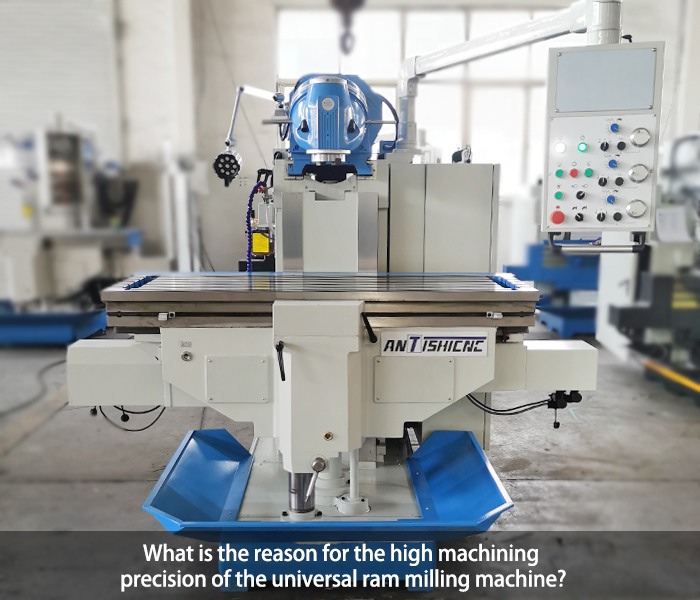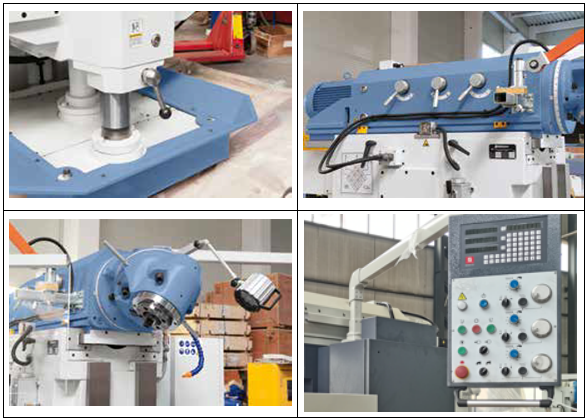The universal ram milling machine drives the spindle to rotate through the motor, driving the milling cutter installed on the spindle to perform high-speed cutting motion. At the same time, the worktable can move in three directions, so that the workpiece is in different positions relative to the milling cutter, thereby realizing the processing of different parts of the workpiece. The rotation of the milling head and the extension and retraction of the ram further increase the flexibility of processing, which can meet the processing needs of various complex shapes and angles.

Structural features
Slide structure: The slide is a key component of this type of milling machine. It can usually be extended and retracted within a certain range. The spindle for installing the milling cutter is located at the end of the slide. Through the extension and retraction of the slide, the distance between the milling cutter and the workpiece can be easily adjusted, which expands the processing range and improves the flexibility and adaptability of the machine tool.
Rotary milling head: The milling head can rotate at multiple angles in space, and can generally achieve any angle of rotation in the front hemisphere. For example, our X 5750 series, the milling head can rotate up to 360°, which is convenient for milling workpieces at different angles. It can mill various shapes such as bevels and grooves.
Workbench system: The workbench usually has a large size and stroke, and can move in three directions: longitudinal, transverse, and vertical. Some are also equipped with a rotary worktable, which can be turned at a certain angle in the horizontal plane, which is convenient for processing workpieces with complex shapes, such as spiral grooves.
Double operating mechanism: Two sets of operating mechanisms are used, one for manual operation and the other for motorized operation. Interlocking devices are provided between motorized, manual and clamping machine tools, which facilitates operation and ensures the safety of machine operation.

The high machining accuracy of universal ram milling machine is mainly due to the following reasons:
1. Machine tool structure design
Rigid structure
The bed, column and other basic components of the universal ram milling machine are usually made of high-strength cast iron or steel. For example, the bed adopts a box-type structure design with internal reinforcing ribs, which can effectively reduce the deformation caused by cutting force during processing. When milling workpieces with large cutting depths or feed rates, the overall stability of the machine tool can be maintained, thereby ensuring processing accuracy.
The design of the ram part is also critical. The ram is generally made of high-quality alloy steel, and its structural shape is optimized to maintain good straightness during the expansion and contraction process. For example, the movement of the ram is guided by a high-precision guide rail system, so that the ram can be accurately positioned at different positions, thereby ensuring that the milling cutter installed at the end of the ram can accurately process the workpiece.
Reasonable layout
The layout of each component of the machine tool is reasonable, and the relative positions between the milling head, ram, and worktable are precisely designed and adjusted. The connection between the milling head and the ram is tight and precise, which can ensure the center position accuracy of the milling head during the rotation process. The movement direction of the worktable (longitudinal, horizontal, and vertical directions) cooperates with the movement of the ram and the milling head. When processing complex-shaped workpieces, it can ensure that the movement accuracy in each direction can still meet the processing accuracy requirements after superposition.
2. Motion system accuracy
High-precision guide rails
Universal ram milling machines usually use high-precision linear guide rails in the direction of ram extension and table movement. These linear guide rails have extremely low friction coefficients and high guiding accuracy. For example, ball linear guide rails are used, and the contact between the ball and the guide rail can provide smooth and precise movement. During the processing, the ram and the table can be guaranteed to move according to the preset trajectory, so that the relative position accuracy between the milling cutter and the workpiece is guaranteed.
The installation and adjustment of the guide rails are also very strict. During the assembly of the machine tool, the straightness, parallelism and other indicators of the guide rails are measured and adjusted by precise measuring instruments to ensure that the accuracy between the guide rails meets the design requirements. This high-precision guide rail system can effectively reduce the error during the movement and improve the processing accuracy.
Precision transmission mechanism
The transmission system plays an important role in the precision control of the milling machine. In the transmission of ram extension and table movement, high-precision ball screws are often used. The ball screw has a high-precision pitch and low transmission error, and can accurately convert the rotational motion of the motor into linear motion. For example, the pitch error of the ball screw can be controlled within a very small range, and the motion accuracy can be further improved through the compensation function of the CNC system.
For the rotary motion of the milling head, a precision worm gear or gear transmission mechanism is used. These transmission mechanisms are precisely processed and assembled to ensure the angular accuracy of the milling head during the rotation process. For example, the worm gear transmission has a high transmission ratio and accuracy. When the milling head rotates a certain angle, it can be accurately positioned to ensure the angular accuracy when processing inclined surfaces or complex curved surfaces.
3. Advanced control system
Compensation function of CNC system
Many modern universal ram milling machines are equipped with CNC systems, which can compensate for the motion errors of machine tools. For example, the geometric errors of machine tools are measured by measuring equipment such as laser interferometers, and the measurement data are input into the CNC system. According to these data, the CNC system automatically adjusts the movement of the ram, worktable and milling head during the processing, and compensates for the errors in real time, thereby improving the processing accuracy.
It can compensate for thermal deformation errors. During the long-term operation of the machine tool, the machine tool parts will be thermally deformed due to factors such as motor heating and cutting heat. The CNC system monitors the temperature changes of key components through temperature sensors, adjusts the motion parameters of the machine tool according to the pre-set thermal deformation model, and reduces the impact of thermal deformation on processing accuracy.
Precise programming control
During the processing process, the operator can accurately control the motion trajectory of the milling cutter through CNC programming. When programming, the starting point, end point, cutting speed, feed rate and other parameters of the milling cutter can be accurately set. For example, when processing complex three-dimensional surfaces, the processing path is converted into a CNC program through mathematical modeling of the surface. The CNC system accurately controls the movement of the machine tool according to the program to achieve high-precision surface processing.
4. Processing technology and tool system
Reasonable processing technology
Before processing, technicians will formulate reasonable processing technology based on the material, shape, precision requirements and other factors of the workpiece. For example, for high-precision plane processing, multiple milling processes will be used. First, rough milling is performed to remove most of the excess, and then semi-finishing milling and fine milling are performed. The cutting parameters of each milling are carefully selected to ensure the flatness and dimensional accuracy of the plane.
When processing workpieces with complex shapes, the processing sequence and tool path planning will be considered. For example, when milling the mold cavity, start processing from the center of the cavity and gradually expand outward. This can reduce deformation during processing and improve processing accuracy.
High-precision tool system
The accuracy of the tool also has an important influence on processing accuracy. Universal ram milling machines usually use high-precision milling cutters with high manufacturing accuracy, including tool diameter accuracy, cutting edge accuracy, etc. For example, the end mill used in fine processing has a very low cutting edge roughness and can process a high-precision surface on the workpiece surface.
The tool installation system is also critical. The use of high-precision toolholders and clamping devices can ensure the concentricity and axial position accuracy of the milling cutter after installation. For example, the use of heat shrinkable toolholders can achieve high-precision installation of the tool, which can ensure the stability of the milling cutter during high-speed milling, thereby improving processing accuracy.
The above is an introduction to the high processing precision of universal ram milling machines. If you also need a suitable universal ram milling machine. Welcome to consult Shanghai ANTISHICNC. We are a senior mechanical equipment supplier with rich experience in mechanical equipment manufacturing and application, and can provide you with professional technical support.
Keywords: Ram milling machine, Universal ram milling machine, Milling machine


